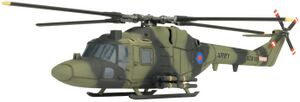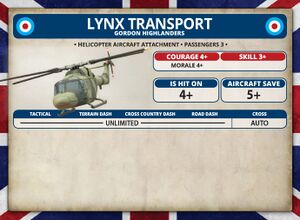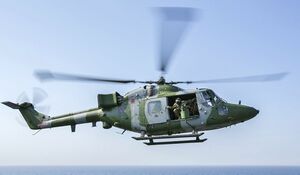Lynx Helicopter: Difference between revisions
1d4chan>Catnip212 |
1d4chan>Catnip212 |
||
| Line 21: | Line 21: | ||
[[File:Lynx in the wild.jpg|right|300px|thumb|The Lynx in the wild]] | [[File:Lynx in the wild.jpg|right|300px|thumb|The Lynx in the wild]] | ||
The Lynx was adopted in 1978 into the British Army Air Corps. Originally a civilian utility helicopter, the design was created to carry heavy loads in a slim, manoeuvrable package. This made it an excellent choice for the role of a gunship; as its small frame made it well suited to shoot and scoot tactics (Hunter-Killer tactics is incorrectly referred to in Iron Maiden; the term refers to having a team with a member designating targets while another actually executes the kill). Other variants for reconnaissance are available, with other gunship variants being equipped on modular pylons with rocket pods, autocannons or TOW missiles. Most transport variants of the Lynx utilized rocket pods or 7.62mm machine guns to try and provide some fire support to the infantry as a last resort. | The Lynx was adopted in 1978 into the British Army Air Corps. Originally a civilian utility helicopter, the design was created to carry heavy loads in a slim, manoeuvrable package. This made it an excellent choice for the role of a gunship; as its small frame made it well suited to shoot and scoot tactics (Hunter-Killer tactics is incorrectly referred to in Iron Maiden; the term refers to having a team with a member designating targets while another actually executes the kill). Other variants for reconnaissance are available, with other gunship variants being equipped on modular pylons with rocket pods, autocannons or TOW missiles. Most transport variants of the Lynx utilized rocket pods or 7.62mm machine guns to try and provide some fire support to the infantry as a last resort. | ||
Revision as of 17:24, 20 February 2018

(For context: heliborne units refer to infantry forces which are transported by helicopter assets. Air Assault forces refer to units whose helicopters were capable of supporting the infantry while landing in combat zones. Airmobile forces refer to units whose helicopters could not be deployed into combat, and would use them as battle taxis. Airborne refers to deployment of vehicles and/or infantry via parachutes, NOT helicopters.)
Distinct from the US and Soviet Heliborne units, the British deployed airmobile units rather than air assault forces. From observations the Vietnam War, the Soviets and Americans designed helicopters which would deploy troops directly into the battle and featured a level of protection against small arms. While the Soviets chose to develop the MI-24 Hind as a flying tank equipped with an autocannon, rocket pods and ATGM missiles despite this machine being used as a simple transport. Units which relied on Hinds include the 13 Air Assault brigades of the VDV, and the Polish 6th Pomeranian Air Assault Division. The US separated their combat and transport helicopters with the Blackhawk toting a pair of door-mounted 7.62mm machine guns. Certain air assault units in the 101st Airborne and the 160th SOAR had their Blackhawks equipped with miniguns, as they were expected to enter active drop zones with a light enemy presence, serving as a blocking force against reinforcements for a certain location or to attack lightly defended locations.
For some absurd reason, the British failed to develop their helicopter tactics and were therefore stuck with the Lynx: an excellent combat helicopter but an incredibly poor choice for heliborne infantry, being more akin to the UH-1 Huey. While most Hueys and Lynx AH-1s were equipped with a 7.62mm machine gun, these are not represented in-game.
Lynx AH-1

In Team Yankee
The Lynx only comes with all airmobile rifle and Milan platoons, meaning that your company HQ has to share a lynx with the rest of the lower classes their brothers in arms. The use of these vehicles is straightforward for the most part; to transport troops into areas where your opponent would not like, such as their backline while using blitz orders to ensure that troops can get out immediately. Blitzing to land, then blitzing the infantry out of the transport. After which, you may consider using them to block enemy movement, such as landing a lynx directly in front of a tank.
Unlike the Hind, the Lynx has a mediocre 5+ aircraft save, and so should not be expected to survive any dedicated anti-air fire.
In Real Life

The Lynx was adopted in 1978 into the British Army Air Corps. Originally a civilian utility helicopter, the design was created to carry heavy loads in a slim, manoeuvrable package. This made it an excellent choice for the role of a gunship; as its small frame made it well suited to shoot and scoot tactics (Hunter-Killer tactics is incorrectly referred to in Iron Maiden; the term refers to having a team with a member designating targets while another actually executes the kill). Other variants for reconnaissance are available, with other gunship variants being equipped on modular pylons with rocket pods, autocannons or TOW missiles. Most transport variants of the Lynx utilized rocket pods or 7.62mm machine guns to try and provide some fire support to the infantry as a last resort.
Lynx AH-1 TOW
In Team Yankee
The FV 438 is an ATGM carrier unique to the Chieftain squadron, and may not be brought more than once unless fielding several squadrons. For 2 points per piece in a 2 or 3 vehicle platoon, you get an AT23 missile which is guaranteed to destroy virtually all tanks in the game without a problem, with the possible exception of the M1IP Abrams. As with all other FV chassis, the 438 is equipped with a 7.62mm machine gun for engaging enemy infantry which gets too close for comfort if you somehow allowed enemy forces into your backline. Unsurprisingly, the FV438 should be fielded as far back as possible, using its superior range 48" to destroy enemy armor. Expect these things to die if touched by anything in the game. It is also one of the only British units equipped with Thermal Vision, allowing you to fire through smoke. Use its Swingfire rule to go-to-ground when firing missiles, making them 6+ to hit or 7+ in cases without the guided special rule.
In Real Life
Fortunately, its real-life effectiveness is far less miserable than its in-game depiction. Rather than being a stationary ATGM wasting valuable points, the Swingfire has a key role in the Chieftain Squadron. Serving as the first line of defense against the hypothetical Soviet hordes, the Swingfire could engage enemy armor from concealed positions and destroy key vehicles such as Command tanks, engineering vehicles or mine-clearing equipped tanks. Rather than a miserable range superiority of an infantryman's running distance, it would require around a minute for a T-72 to get into range to engage a unit of Swingfires assuming that the sods decide to stay and fight. Conversely, Soviet forces may choose to stop the advance and engage with artillery or their own ATGMs, which would not only slow the advance but also delay the Soviet advance significantly. The FV438 remains in service under the Royal Armoured Corps.
| British Forces in Team Yankee | |
|---|---|
| Tanks: | Chieftain - Challenger 1 |
| Transports: | Spartan Transport - FV432 Transport - FV510 Warrior - Lynx Transport |
| Infantry: | Mechanized Company - Milan Section (Mechanized) - Airmobile Company - Milan Platoon (Airmobile) - Support Troop |
| Artillery: | Abbot Field Battery - M109 Field Battery - FV432 Mortar Carrier -M270 MLRS |
| Anti-Aircraft: | Spartan Blowpipe - Tracked Rapier - Chieftain Marksman |
| Tank Hunters: | Striker - Spartan MCT - Swingfire |
| Recon: | FV432 FOO - Scorpion - Scimitar -FV721 Fox |
| Aircraft: | Harrier Jump Jet - Lynx HELARM |